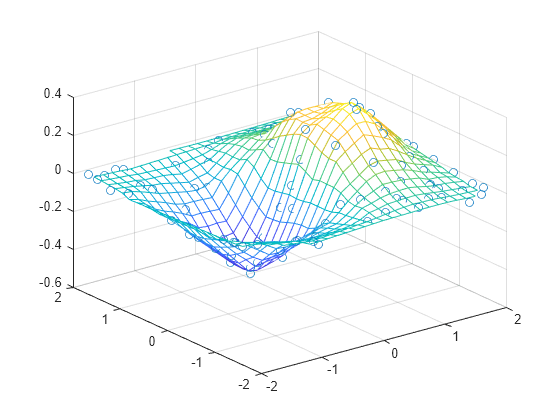TriScatteredInterp
(Not recommended) Interpolate scattered data
TriScatteredInterp is not recommended. Use scatteredInterpolant instead.
Description
TriScatteredInterp is used to perform
interpolation on a scattered dataset that resides in 2-D or 3-D space. A scattered data set
defined by locations X and corresponding values V can be
interpolated using a Delaunay triangulation of X. This produces a surface
of the form V = F(X). The surface can be evaluated at any query location
QX, using QV = F(QX), where QX lies
within the convex hull of X. The interpolant F always
goes through the data points specified by the sample.
Creation
Syntax
Description
F = TriScatteredInterp creates an empty scattered data
interpolant.
F = TriScatteredInterp(
creates an interpolant that fits a surface of the form Q,V)V = F(Q) to the
scattered data in (Q, V). Q is a
matrix of size mpts-by-ndim, where
mpts is the number of points and ndim is the
dimension of the space where the points reside (ndim is 2 or 3). The
column vector V defines the values at Q, where the
length of V equals mpts.
F = TriScatteredInterp(
uses the specified DT,V)DelaunayTri object DT as a basis for
computing the interpolant. DT is a Delaunay triangulation of the
scattered data locations, DT.X. The matrix DT.X is
of size mpts-by-ndim, where mpts
is the number of points and ndim is the dimension of the space where
the points reside, 2 <= ndim <= 3. V is a
column vector that defines the values at DT.X, where the length of
V equals mpts.
F = TriScatteredInterp(___,
specifies the interpolation technique method)method used to interpolate the
data. You can use any of the previous input argument combinations.
Input Arguments
Properties
Object Functions
To evaluate the interpolant, express the statement in Monge's form Vq =
F(Xq), Vq = F(Xq,Yq), or Vq = F(Xq,Yq,Zq)
where Vq is the value of the interpolant at the query location and
Xq, Yq, and Zq are the vectors of
point locations.
Examples
More About
Extended Capabilities
Version History
Introduced in R2009a
See Also
triangulation | delaunayTriangulation | scatteredInterpolant | interp1 | interp2 | interp3 | meshgrid
